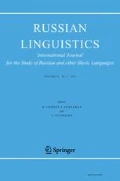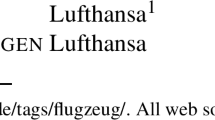Abstract
This paper investigates three phenomena that involve genitive Case-assignment to the direct object in Russian: Genitive of Negation, Intensional Genitive and Partitive Genitive. I argue, following Neidle (1988), that Genitive of Negation and Intensional Genitive share a considerable number of properties and should be provided a unified account. It is proposed that both phenomena are sensitive to the notion of ‘existential commitment’: the choice of genitive Case is strongly associated with the lack of commitment to the existence of the referent. A distinction between different types of existential commitment is introduced, with each type determining Case-assignment in a certain class of sentences. The picture is then extended to include Partitive Genitive. Numerous properties differentiate this Case from both Intensional Genitive and Genitive of Negation. However, despite these differences, all the three types of genitive Case are unified by a the non-specific, indefinite interpretation. I propose that this complex pattern can be accounted for by means of the notion of ‘individuation’. All the types of genitive nominals under investigation are non-individuated, which accounts for the observed similarity. The difference between Partitive Genitive and the other Cases is proposed to result from the fact that different types and sources of non-individuation are involved.
Аннотация
В предлагаемой статье исследуются три вида родительного падежа прямого объекта: родительный падеж в отрицательном предложении, интенциональный родительный падеж и партитивный родительный падеж. Отстаивается точка зрения, впервые предложенная Neidle (1988), согласно которой родительный падеж в отрицательном предложении и интенциональный родительный падеж должны анализироваться как единое явление. Демонстрируется, что выбор падежа в рамках данного явления обусловлен в большой степени понятием ‘существования’. Использование родительного падежа свидетельствует об отсутствии уверенности в том, что референт фразы существует. Приводится несколько подвидов ‘приверженности существованию’ (existential commitment), каждый из которых отвечает за выбор падежа в определенной группе предложений.
Демонстрируется также, что партитивный родительный падеж существенно отличается от двух других исследуемых видов родительного. Отличие проявляется как в семантических, так и в грамматических свойствах прямого объекта. В то же время, все три вида родительного падежа объединяют такие свойства как нереферентность и неопределенность. Как сходство, так и различия между данными видами родительного падежа могут быть объяснены при помощи понятия индивидуации. Все исследуемые в статье виды родительного падежа характеризуются низким уровнем индивидуации, что является основой семантического сходства. Различия между партитивным родительным и другими видами родительного падежа связаны с тем, что мы имеем дело с разными причинами и разными подвидами низкой индивидуации.
Similar content being viewed by others
Литература
Aissen, J. (2003). Differential object marking: iconicity vs. economy. Natural Language & Linguistic Theory, 21(3), 435–483.
Babby, L. H. (1978). Negation and subject case selection in existential sentences. Evidence from Russian. Bloomington.
Babyonyshev, M. (2006). The extended projection principle and the genitive of negation construction. In S. Brown & A. Przepiórkowski (Eds.), Negation in Slavic (pp. 31–69). Bloomington.
Bailyn, J. F. (1997). Genitive of negation is obligatory. In W. Browne et al. (Eds.), Annual workshop on Formal Approaches to Slavic Linguistics. The Cornell meeting (Michigan Slavic Materials, 39) (pp. 84–114). Ann Arbor.
Borschev, V., & Partee, B. H. (1998). Formal and lexical semantics and the genitive in negated existential sentences in Russian. In Ž. Bošković, S. Franks & W. Snyder (Eds.), Annual workshop on Formal Approaches to Slavic Linguistics. The Connecticut meeting 1997 (Michigan Slavic Materials, 43) (pp. 75–96). Ann Arbor.
Borschev, V., & Partee, B. H. (2002). The Russian genitive of negation in existential sentences: the role of theme-rheme structure reconsidered. In E. Hajičeová & P. Sgall (Eds.), Travaux du Cercle Linguistique de Prague n.s., Prague Linguistic Circle Papers. Vol. 4 (pp. 185–250). Amsterdam.
Brown, S. (1999). The syntax of negation in Russian. A minimalist approach. Stanford.
Dambriunas, L. et al. (1980). Introduction to modern Lithuanian. New York.
Farkas, D. F. (1985). Intensional descriptions and the Romance subjunctive mood. New York.
Franks, S. (1995). Parameters of Slavic morphosyntax. New York.
Franks, S., & Dziwirek, K. (1993). Negated adjunct phrases are really partitive. Journal of Slavic Linguistics, 1(2), 280–305.
Frege, G. (1997). On Sinn and Bedeutung (1892). In M. Beaney, The Frege reader (pp. 151–171). Oxford.
Harves, S. (2002). Genitive of negation and the syntax of scope. In M. van Koppen, E. Thrift, E. J. van der Torre & M. Zimmerman (Eds.), Proceedings of ConSOLE IX (pp. 96–110). Leiden.
Hopper, P. J., & Thompson, S. A. (1980). Transitivity in grammar and discourse. Language, 56(2), 251–299.
Kagan, O. (2005). Genitive case: a modal account. Proceedings of The Israel Association for Theoretical Linguistics, 21. http://linguistics.huji.ac.il/IATL/21/Kagan.pdf. Accessed 24 November 2009.
Kagan, O. (2007a). A modal analysis of genitive case in Russian. In P. Kosta & L. Schürcks (Eds.), Linguistic investigations into formal description of Slavic languages. Contributions of the sixth European conference held at Potsdam University, November 30–December 02, 2005 (Potsdam Linguistic Investigations, 1) (pp. 217–226). Frankfurt.
Kagan, O. (2007b). On the semantics of structural case. Unpublished Ph.D. dissertation. The Hebrew University of Jerusalem.
Klenin, E. (1978). Quantification, partitivity, and the genitive of negation in Russian. In B. S. Comrie (Ed.), Classification of grammatical categories (pp. 163–182). Edmonton.
Lunt, H. G. (1955). Old Church Slavonic grammar. Leiden.
Nau, N. (1998). Latvian (Languages of the world. Materials, 217). München.
Neidle, C. (1988). The role of case in Russian syntax. Dordrecht.
Partee, B. H., & Borschev, V. (2004). The semantics of Russian genitive of negation: the nature and role of perspectival structure. http://people.umass.edu/partee/docs/SALT14ParteeBorschev.pdf. Accessed 8 October 2009.
Pereltsvaig, A. (1999). The genitive of negation and aspect in Russian. In Y. Rose & J. Steele (Eds.), McGill Working Papers in Linguistics 14(1, 2) (pp. 111–140). Montreal.
Pesetsky, D. M. (1982). Paths and categories. Cambridge. http://hdl.handle.net/1721.1/15467. Accessed 8 October 2009.
Sawicki, L. (1988). Verb-valency in contemporary Polish. A study of the major valency-types (Tübinger Beiträge zur Linguistik, 319). Tübingen.
Strawson, P. F. (1950). On referring. Mind. New Series, 59(235), 320–344.
Timberlake, A. (1986). Hierarchies in the genitive of negation. In R. D. Brecht & J. S. Levine (Eds.), Case in Slavic (pp. 338–360). Columbus.
Zimmermann, T. E. (1993). On the proper treatment of opacity in certain verbs. Natural Language Semantics, 1(2), 149–179.
Падучева, Е. В. (1992). О семантическом подходе к синтаксису и генитивном субъекте глагола быть. Russian Linguistics, 16(1), 53–63.
Падучева, Е. В. (1995). Видовая парность и количественный предел действия: почему нельзя сказать ‘Я пью воды?’. Русистика сегодня, 3, 38–50.
Падучева, Е. В. (1997). Родительный субъекта в отрицательном предложении: синтаксис или семантика? Вопросы языкознания, 2, 101–116.
Падучева, Е. В. (2004). Динамические модели в семантике лексики. Москва.
Author information
Authors and Affiliations
Corresponding author
Additional information
I wish to thank Edit Doron, Malka Rappaport-Hovav, Donka Farkas, Barbara Partee, Vladimir Borschev, Elena Padučeva, Asya Pereltsvaig, Natalia Kondrashova, Fred Landman, Ariel Cohen, Lea Sawicki, Ede Zimmermann and Yael Sharvit for fruitful discussions. I am also grateful to the audiences of IATL 21, FDSL 6, SALT 17 and FASL 17 for insightful comments. All mistakes are my own. This research has been partially supported by ISF grant 615/06.
Rights and permissions
About this article
Cite this article
Kagan, O. Genitive objects, existence and individuation. Russ Linguist 34, 17–39 (2010). https://doi.org/10.1007/s11185-009-9051-x
Published:
Issue Date:
DOI: https://doi.org/10.1007/s11185-009-9051-x




